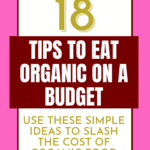THIS POST MAY CONTAIN AFFILIATE LINKS. PLEASE SEE MY DISCLOSURES. FOR MORE INFORMATION.
When it comes to our bodies and ways to eat healthily, people will give you all sorts of tips – the keto diet is the best for losing weight, caffeine is bad for you until it’s good for you, avoid potatoes because they have no nutritional value, and what not!
It can be hard to keep up, but one thing that most people seem to agree on is eating organic.
While eating organic food is touted as one of the best things for your health, its cost is a considerable barrier for many consumers who can’t afford it. Check as many grocery stores as you want, and you’ll notice that organic brands and products are much more expensive than conventional food and groceries.
Don’t worry! There are several ways to make organic groceries accessible for all.
In this post, I share with you the best ways to eat organic on a budget. By the end, you will be able to put food on your table and still have money left over!
Table of Contents
What Are Organic Products?

Most people have a general idea of what organic food is. Images of fresh veggies, local farms, and a farmer’s market are the first things to come to mind when talking about organic food.
According to the USDA, products are considered organic if no synthetic pesticides or fertilizers are used or applied three years befre harvesting.
Organic meat and organic milk should come from animals that are fed natural feed and are hormone-free, meaning they’re not given synthetic hormones. If these requirements are met for fresh and frozen foods, the government puts a USDA organic seal or label on the package to denote the same.
Food labels that state their products are “natural” or “pasture-raised” should be taken with a grain of salt. There is no legal definition of “all-natural,” so it can still contain processed ingredients. The same goes for free-range.
While it may seem you’re buying organic items that are healthier than processed foods, these terms are misleading and do not represent USDA-approved organic food items.
18 Best Ways To Buy Organic and Save Money
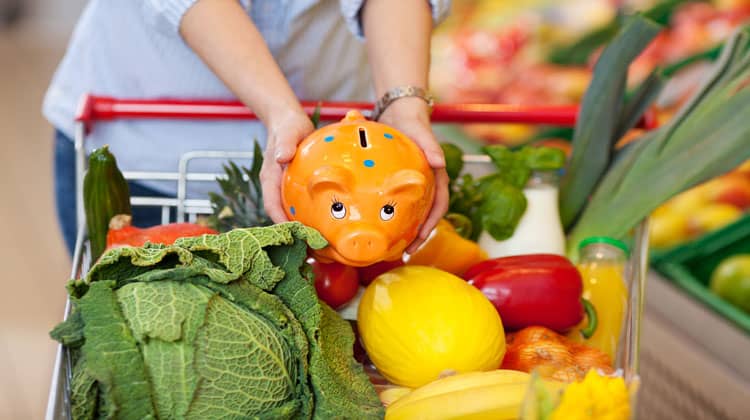
With some planning and research, eating organic foods and stretching your budget can be a cakewalk! Below are the best tips for buying organic on a budget.
1. Make the Best Choice
When you want to eat organic on a budget, the kind of foods and products you choose can make a huge difference.
The nonprofit Environmental Working Group publishes an annual list called “Dirty Dozen” and “Clean Fifteen.” Both these lists help consumers buying organic produce decide what they should choose.
The “Dirty Dozen” are the fruits and vegetables that rank highest in pesticide residue. Consumers should forego saving money and spend more on this produce. This year’s list includes fruits and vegetables such as strawberries, apples, spinach, and celery.
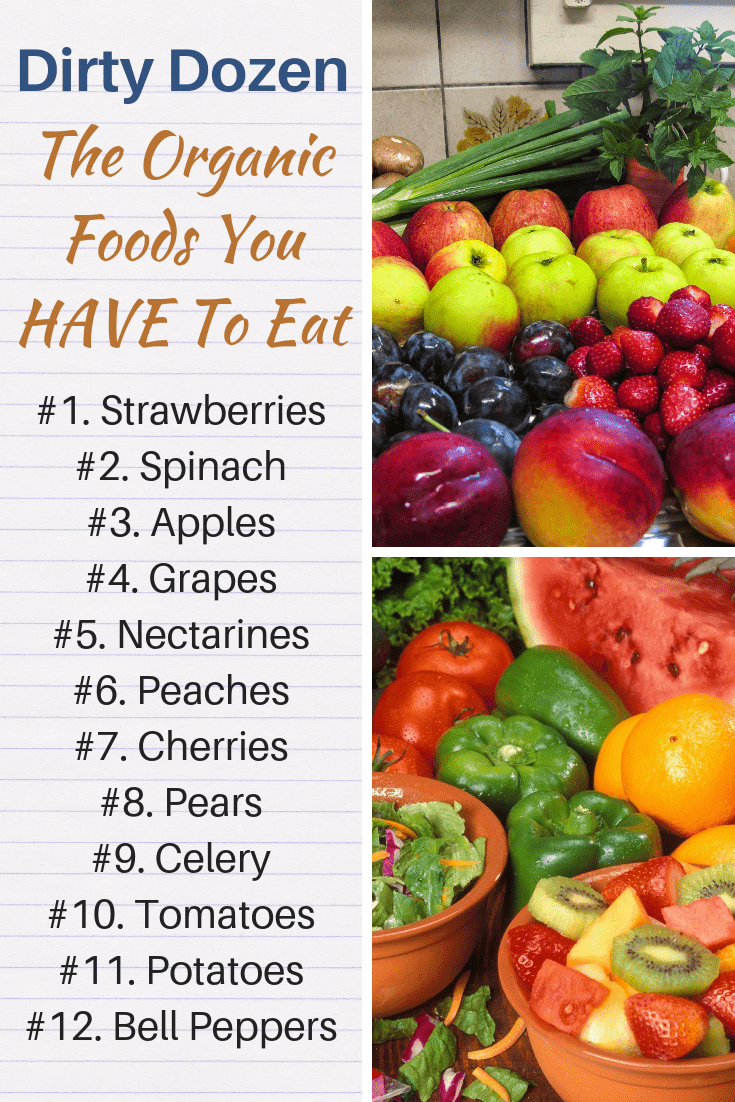
The “Clean Fifteen,” on the other hand, is the fresh produce that has the least amount of pesticide residue. The list includes items such as sweet potatoes, avocados, pineapples, and frozen produce like sweet peas.
With this in mind, it’s best to eat organic produce from the “Dirty Dozen” and go with the cheaper, non-organic produce from the “Clean Fifteen.”
This will help you save money and make better grocery shopping choices.
2. Decide What You Need
Not all organic products are necessary for a healthy lifestyle.
Certified organic cookies and candies, seemingly a good thing, aren’t that different from regular sweets.
Even if something is labeled organic but processed, it won’t be much healthier. A better option would be to stop buying these items or make them a special treat you eat once in a while.
3. Purchase In-Season
Another tip for people on a tight budget who want to save money is to buy organic food that is in season.
Buying organic fruits, such as peaches, in the summer will be much more affordable because fewer resources are needed to keep the produce thriving. For example, peaches thrive in warm weather and full sunlight. Growing them in the winter will require artificial heat and sun, which can be a substantial additional cost.
You should research what products are in season.
Conventional foods let consumers eat fruits and other items year-round, but it comes at a cost.
If you love a particular type of food or organic item, you can always buy a lot of it and then save it for another season via freezing, pickling, or drying it out.
4. Opt for Frozen Food Items
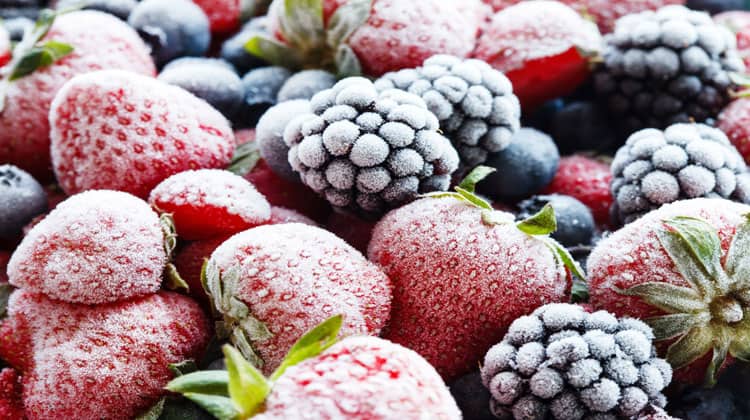
There is a stigma that frozen food items aren’t as good as fresh items, especially when it comes to organic food, but that isn’t true.
More consumers can afford organic food when they opt for frozen fruits and vegetables, which studies have shown to have similar nutritional values.
5. Check Out Local Farmers
Another way to save money is to buy directly from nearby local farmers.
Many of them will have organic foods, including organic meat and organic milk, that will be pesticide and hormone-free.
While they may not be as cheap as a grocery store, farmer’s markets support your neighborhood farmers, and they will have a greater variety of organic food. However, just because you are buying locally, don’t assume the food is organic.
You need to ask how they grow their crops and if pesticides or other chemicals are used.
6. Join a CSA
Some cities and towns offer community-supported agriculture programs, or CSAs, letting consumers buy directly from farmers.
These tend to be quite affordable since the CSAs are often based on a pre-set payment plan for organic foods.
At the beginning of the season, you agree to pay a share amount. The larger the share amount, the more food you get. Then, for a set number of weeks, you go to a pre-determined location and pick up your food. The food you get varies each week as it is harvested.
So at the beginning of the summer, you might get tomatoes, cantaloupe, carrots, and more, and by the end of the summer, you may get cucumbers, potatoes, lettuce, and more.
You can read more about CSA and its advantages and find a local CSA at LocalHarvest.
7. Visit Farmers’ Markets
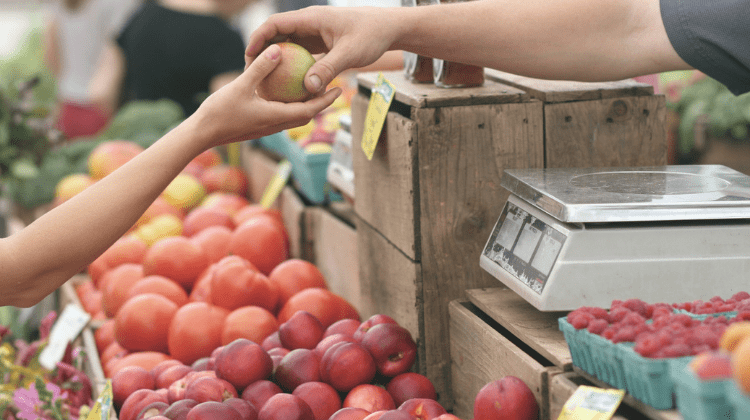
Another option is to visit your local farmers’ markets. These markets can be a set location open for a few hours on Saturday morning or a roadside stand.
Here you will have many farmers offering their food for sale, and you can find what you need. As a bonus, many markets also have people selling other organic foods, most times at a lower price than the grocery store.
8. Consider Buying Seconds
What are seconds, you ask? These are fruits and vegetables that are bruised or don’t look pristine. As these foods have blemishes, they can’t be sold in the grocery store.
If you can overlook this, you can save a ton of money, and even if you have some issues with their looks, you can use them in making other delicacies. For example, I buy a 10-pound box of apple seconds for $10 at the local farmer’s market and make homemade applesauce and freeze most of it. I make an apple pie or two as well.
You can do the same and even take vegetable seconds and use them in soups and stews.
9. Find Online Farms
More and more farmers realize they can reach customers by selling their products online. Plus, selling directly to consumers can lower their costs and make them earn more money.
As a result, you can find many options for organic food online.
Not only can you buy produce, but also meat and, in some cases, dairy products.
Many offer subscription boxes as opposed to being able to pick individual items to buy. But most offer a large variety of boxes, so there will be a version that makes sense for you.
10. Pick Your Own Food
Another great way to save money is to visit farms that allow you to pick your own organic vegetables and fruits. You usually get a lower price on the food you buy since you are doing the work of picking it.
If you have young children who will love picking the food with you, you can make it a family adventure.
Saving time and money and having fun is a winning combination for most people.
- Read now: Learn how to value time vs. money
11. Grow Your Produce

If you have the resources and the space, growing your organic fruits and vegetables is a budget-friendly way to start eating organic.
The great thing about growing on your own is knowing what is going into your soil and how your fresh produce is being taken care of.
You can also reduce food waste because you know what you’re growing and aren’t trying to estimate how much food you’ll need for an entire city.
If you are short on space, consider indoor gardening.
While you won’t be able to grow as much food, you can at least figure out the foods you eat most often and grow them to help lower the cost of your budget.
12. Buy Stores’ Organic Brands
Grocery store organic products can be another easy way to save money and get organic food on a budget.
The O Organics, a USDA-certified organic and non-GMO brand, is a popular choice for cheaper organic food and is sold at grocery stores like Safeway, Vons, and Shaw’s.
Other places like Trader Joe’s, Aldi, and Costco offer budget-friendly ways to buy organic food on a tight budget, thanks to their store-branded products.
Many stores are now offering organic food at lower prices, so the next time you go shopping, ask where the organic section is.
13. Use Bulk Bins
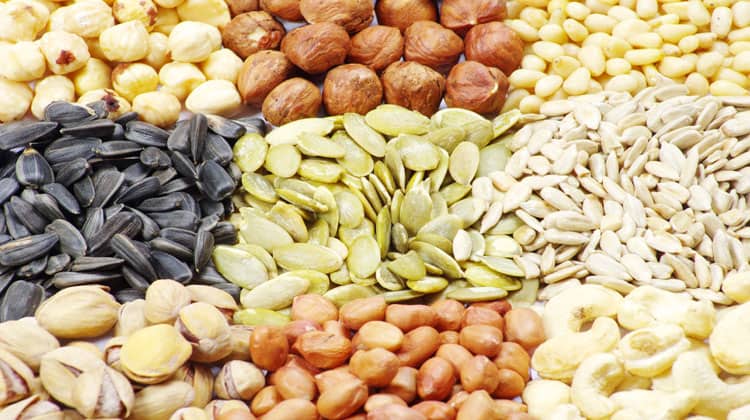
Using the bulk bins to buy loose nuts, grains, spices, and seasonings is another way to save.
Since you are cutting out the middlemen and all the packaging, buying this way will save you considerable money.
Don’t let the word bulk scare you! You can buy as much or as little as you need. It isn’t a warehouse store where you have to buy a 10-pound container of cinnamon.
14. Shop at an Online Grocery Store
Organic food has become more convenient, thanks to several online grocery stores specializing in organic foods.
Companies like Thrive Market and Imperfect Foods offer consumers certified organic products.
Not everyone has access to organic stores or farmer’s markets, so finding organic food on a budget from the convenience of your computer is appealing.
Ground beef, fresh herbs, dairy products, and various other organic food items can be delivered right to your home with just a click! Sometimes these companies will even offer organic coupons or free shipping, making it easier to afford organic food.
15. Check Out Dollar and Discount Stores
While it is not a guarantee that you will find organic food at a dollar store or a discount store like Big Lots, you get lucky from time to time.
So if you regularly shop at these stores, keep an eye out for organic. Every once in a while, you might be able to find organic bread or other pre-packaged food you can buy at a discount.
16. Look for Sales

Paying attention to sales is another easy way to lower your costs.
Not only do you get your groceries at a reduced cost, but you can also meal plan around the sales to save even more.
Stores tend to offer sales in cycles, and if you don’t miss out on these, you can save a lot of money.
- Read now: Learn how to save money using grocery store sales cycles
- Read now: Find out how to play the drugstore game and save money
So gather up the weekly sales flyers and make a note of what is on sale!
17. Shop Around
If you have a variety of stores in your area, make it a point to visit each and check out the prices. You might be shocked at how much prices vary for the same foods. In my area, a pint of organic blueberries ranges from $2.99 to $7.99.
The bottom line is that it pays to shop around.
If time is a premium for you, make a list of the items you buy most often, take a trip to each store and write down the non-sale price for each item – now you know where to shop to save money!
If you still don’t think you have time to visit each store, consider shopping online and picking up your groceries curbside. More supermarkets are offering this service, and many don’t charge extra.
- Read now: Learn the steps to becoming rich
18. Use Your Credit Card
Finally, consider using a cashback credit card when you shop.
Using a card that offers cashback effectively lowers the price you pay for your groceries.
For example, I use the American Express Blue Cash Preferred card and get 6% cash back on my groceries. So each week, when I spend $100 on food, I get $6 cash back.
Of course, to truly save money, you have to pay your bill in full each month, but if you are disciplined, this is easy to do and an easy way to save.
Final Thoughts
You can eat organic on a budget, but you have to realize that it will take a little effort, especially in the beginning, as you figure out the best places to shop, offering the lowest prices.
But once you do this, you can buy cheap organic groceries, allowing you to save money and eat healthily.
Frequently Asked Questions (FAQs)

Here are the most common questions I get about organic food and saving money:
1. What is the cheapest organic food?
Now that you have some tricks up your sleeve on buying organic products on a budget, take note that some organic foods are a great deal while still rocking the USDA-organic label:
- Beans, the powerhouse dried foods, are full of fiber, and a little goes a long way, so they will likely last you a very long time. They are easy to store and don’t usually have contamination from the BPA in cans.
- Tea is easy to prepare and can be even cheaper if you buy the loose-leaf kind rather than the bagged kind.
- While fresh organic fruits can get expensive, the frozen kind tends to be cheaper and can last anywhere from six to twelve months.
- The humble potato is one of the cheapest organic foods and fits nicely with any budget and diet.
2. What is the best place to buy cheap organic groceries?
Some of the best places to buy organic include buying directly from farmers and shopping at discount grocers.
- When you buy directly from a farmer, you cut out the cost of transporting the food to the grocery store and their markup, saving you money.
- Discount grocers, such as Aldi or Walmart, tend to offer lower prices. I shop at Aldi, and my grocery bill comes to around $100-$125 weekly, feeding a family of four.
If you insist on shopping at traditional grocery stores like Wegmans, buy the in-house organic product lines, as these will be cheaper than name brands.
3. Why is organic food more expensive?
According to a study by Consumer Reports, buying organic can cost up to 47% more money because they have to be grown naturally, and the items needed for this will cost more. The higher the production costs, the more you’ll have to pay. Plus, premium pricing also plays a role.
Grocers charge more because more affluent people tend to buy organic and the landscaping company knows such people can afford to pay a higher price.
4. Is paying extra money to eat organic worth it?
Yes and no. If you eat the foods on the Dirty Dozen list, it makes sense to buy organic. But for other foods, organic doesn’t necessarily mean healthy food. The best use of your money is to buy some organic food and then focus on eating healthier.
- Read now: Learn how to save $100,000 fast
- Read now: Here are the best frugal living tips
- Read now: Find out how to save money like a millionaire
I have over 15 years experience in the financial services industry and 20 years investing in the stock market. I have both my undergrad and graduate degrees in Finance, and am FINRA Series 65 licensed and have a Certificate in Financial Planning.
Visit my About Me page to learn more about me and why I am your trusted personal finance expert.

